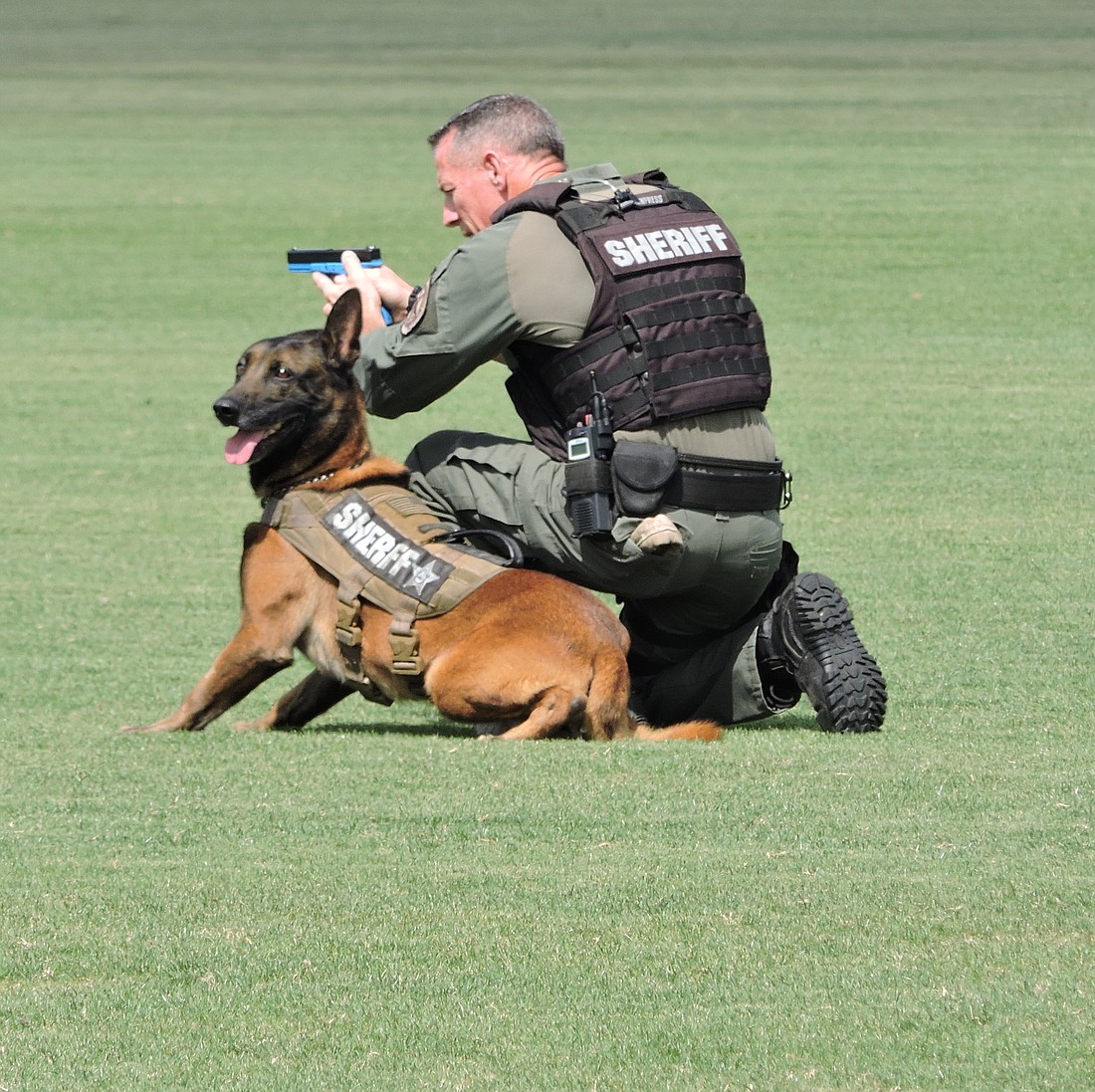- April 16, 2024
-
-
Loading

Loading

Before Sgt. Stephen Chenard of the Manatee County Sheriff's Office talked about the value of the nine police dogs under his supervision, he told a story.
It occurred a little more than two years ago, in a wooded area near the corner of Cortez Road and 75th Street West in Bradenton. Deputy Thomas Franklin was following two dangerous suspects with his fellow deputies.
Franklin came upon one of the suspects who was laying in the grass. That man started to crawl away as the deputies approached. Franklin decided it was time to employ his dog, Quinto, and released him to subdue the man.
Quinto, though, had other ideas. He took a few steps, then took a hard right. Hiding in the brush was the other suspect, who had a revolver. If any of the deputies had taken a few more steps forward, they might not have survived an arrest that eventually was executed with limited resistance.
On March 11 at the Sarasota Polo Club in Lakewood Ranch, Chenard led a public demonstration of his canine unit. More than 5,000 polo fans showed up for the regularly-scheduled match, so it presented a great opportunity for Chenard and his unit's dogs to show off.
Three deputies, Mike Gerholdt, Chris Thames and Charles Wolfinger, brought their dogs in an effort to educate the crowd. Gerholdt took the field first with his dog, Boey, and they performed drills that displayed Boey's discipline. As Gerholdt moved forward with a pistol in a ready position, Boey hugged his side and obeyed his every command.
Thames later gave his dog, Echo, the order to help subdue a fleeing suspect, which in this case was Wolfinger, who wore a protective sleeve to absorb Echo's bite. Wolfinger ran down the middle of the field, and Echo gobbled him up in a few seconds. Criminals beware.
The display, though, wasn't as dramatic as the stories themselves.
Chenard told the crowd about the dogs, "They will gladly lay their life down to protect ours."
A few moments later, Thames told a story to reinforce Cherard's point.
"I was serving a warrant on a male for two attempted murders," Thames said. "On surveillance, I saw him and I parked my car around the corner. When I saw him, I told him to stop, and I initiated my dog (Leo at the time) and he bit him in the wrist as the man was going for the gun in his waistband.
"I'm glad Leo was there, or maybe I wouldn't be."
Wolfinger's former dog, Rex, came up big during the search of a violent suspect who deputies thought had run out of a yard. While the deputies talked about where the man might have gone, Rex started barking at a kennel inside the yard. Indeed, the suspect was hiding there and deputies surrounded him quickly and made the arrest.
"It's amazing how perceptive they can be," Wolfinger said.
All nine members of the canine unit could tell stories about how their dogs might have stopped a situation from becoming violent. However, they are valuable on plenty other fronts as well.
"Think of the money our taxpayers save in the evidence we find, and the seizures," Thames said.
The Sheriff's Office has five other dogs that aren't part of Chenard's unit. Two are multipurpose dogs, one is trained for ballistics, another for finding electronics evidence and the other is sort of mascot who appears are scheduled presentations.
The nine dogs in the regular canine unit are used to track and engage criminals. Seven of those are skill in the detection of narcotics and the other two are "bomb dogs."
In 2016, those nine dogs were vital in the apprehension of 224 criminals.
"Those criminals otherwise might have been caught later, but we were apprehend them quickly and that also allows us to gather more evidence."
The dogs must perform because Chenard said it costs about $100,000 the first year a dog goes into service. That includes intensive training and an extensive bonding period with their future handlers. New handlers must have a 480-hour training block.
"All our handlers live 24/7 with their dogs," Chenard said. "When they take them home, the dogs don't live inside. You won't see them on the couch eating potato chips. You ask them to do things you wouldn't want to do.
"More than anything, I've learned these dogs are very intelligent. They understand and know how to do their job. You learn to trust your dog. We've had witnesses said the suspect went south and your dog goes north. I've gone south before. Now I trust my dog."
Three years after Chenard crossed over to the canine unit, he says he wouldn't have it any other way.
"Every day is incredible," he said. "It's an amazing thing to see. Everything we do is based on that bond. That bond was very surprising for me. That bond becomes similar to one of your children. We've been through a lot together."
How strong of a bond is it?
Wolfinger said he would have trouble going back to a human partner.
"My dog is happy to see me every day," said Wolfinger, who has been with the canine unit for 7 1/2 years. "And he always does what I ask without question."